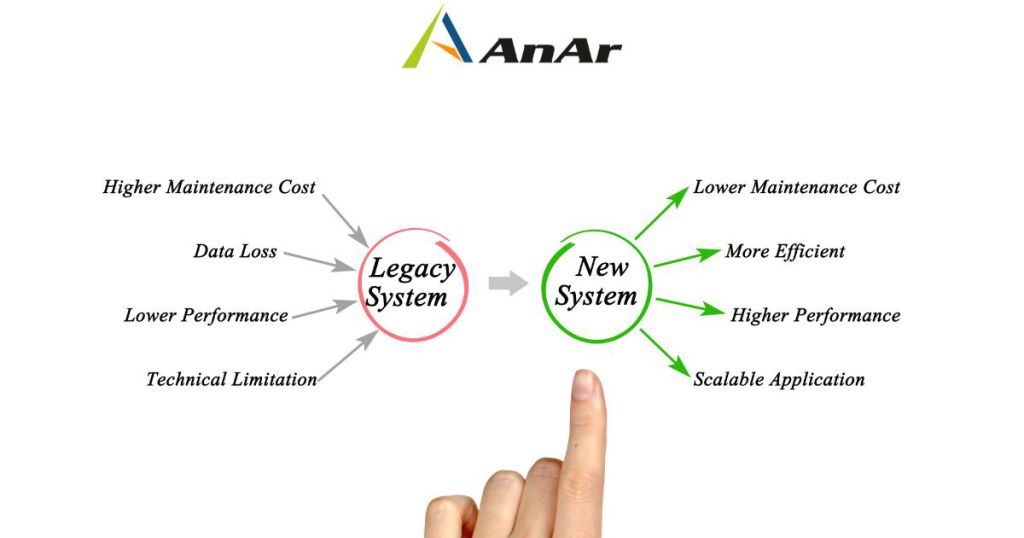Low code for legacy application modernization can help you save time and money. Learn about the top benefits of using low code for your next project. Continue reading to dive deeper 🔥
The last few years have made organizations rethink how they operate internally and externally and how their organization interacts with their customers and other stakeholders, realizing that their legacy systems need an overhaul. The end of support for several apps has led to unresolved security, compliance, and other problems. Others are so out-of-date that finding someone with the knowledge to maintain them is challenging. Additionally, few require a functional redesign to become competitive, agile, and mobile-first organizations.
Your company’s present legacy systems are unquestionably essential to its operation, but how efficiently are they truly performing?
Yes, they may occasionally function flawlessly, but is your IT staff clinging to them by a thread? Are lags making it harder for you to receive the answers you need?
Do you think there are more bugs every day?
If this sounds familiar, it’s probably time for an update to your legacy systems. Low-code can provide a sensible, sophisticated, and flexible choice for your legacy system modernization needs, which might probably be what you need to support application modernization.
Don’t fall behind.
Your company may struggle to expand and remain competitive due to outdated systems. Excel spreadsheets, for instance, have limitations in terms of what you can accomplish with them, even though they could be crucial to your daily operations. On the other hand, a low-code solution might assist you with digitizing and automating your workflows.
Older legacy systems have a lot of unaccounted-for expenses. Your IT personnel must spend precious time and effort on ongoing updates and maintenance, which adds up. Additionally, many older systems are finding it harder and harder to integrate new applications and programs. The demand for firms to be as agile as possible makes it problematic if they can’t swiftly deploy, test new concepts, and pivot. Additionally, outdated systems are frequently incompatible with software designed to streamline workflows and automate procedures, leaving firms stranded and searching for an alternative.
The solution is to update the internal systems that your applications communicate with; this does not imply that modernizing legacy programs is as simple as switching on a switch. You should avoid rushing into revamping or replacing a complete legacy system.
You must take the following factors into account:
- How do you plan to guarantee that any new procedures and software applications abide by any applicable legal or compliance requirements?
- How do new systems interact with your existing legacy systems?
- How to keep a new system under quality control and secure?
- How much the improvements will cost, how long they’ll take, and how long it’ll take to educate the staff
Businesses must compare the costs of maintaining current operations with the time and resources needed to modernize their legacy systems. They’ll then need to come up with the appropriate answers.
What is Low-Code?
Low-code is a method of software development that makes it possible to provide apps more quickly and with less hand-coding.
What is a Low-Code Platform?
A suite of tools known as a low code platform enables the visual development and delivery of applications. Low-code platforms come with a drag-and-drop interface. You may utilize low code to quickly and visually develop entire apps with contemporary user interfaces, integrations, data, and logic without o writing thousands of lines of complicated code and grammar.
Low-Code Upgrade Procedures for Legacy Systems
Whether you’re looking to update a few core business processes or completely rebuild, legitimate low code platforms like Appian Low Code can replace, enhance, or supplement your old systems and applications.
Here’s how to approach it:
Identify the legacy applications
An organization will ultimately upgrade its hardware, programming language, operating system, or the corresponding software; outdated systems cannot be retained and used continuously. Modernization and transfer include modifying, combining, or reusing legacy software code to satisfy current business requirements. For example, Microsoft stopped support for Windows 7 on 14 January 2020. Users who wish to continue using Windows 7 can do so; however, many apps will no longer be compatible; and Microsoft will not patch any vulnerabilities or bugs in the application, rendering all versions before Windows 7 old software.
Enhance your systems’ capabilities
Maintain your core system while creating extensible, open apps that integrate smoothly with your existing framework. You can gradually transfer the data from the legacy system using a low code platform, which also enables the creation of new versions of the program with features that surpass those of the original application.
Change to a more modern architectural style
You can progressively replace legacy applications by creating more modern ones. Look for locations in your system where you can implement progressive changes. By concentrating on the most crucial components first, it is possible to streamline the replacement process. As new apps are published, you can decommission legacy ones.
Benefits of Modernizing Legacy Systems with Low-Code Platforms
Legacy modernization has always been time- and money-consuming. However, employing a low code solution to modernize has only recently been a possibility for businesses. When considering low code for legacy modernizations, the decreased delivery time is frequently the first benefit that comes to mind, but it’s not the only one.
Agility
By allowing the use of drag-and-drop components and model-driven logic through a graphical user interface (instead of coding), low-visual code’s design features significantly shorten the time it takes to construct a new application.
Increased productivity
You can now complete in a matter of weeks or even days, which once required months to complete. Low code development has removed time as a barrier to meaningful innovation. The low code implementation makes it easier to reuse modules and functions, which improves consistency.
Quality enhancement
Because you have to type less code when employing low code, errors are less likely to occur. Even though testing is still crucial to low-code development, standard components and modules provide the application’s functionality, enabling the “test once, use many times” approach.
Reusable data models
Have you got any outdated modules? Are you expecting any future business requirements? You won’t have to redo anything with low code because you may use pre-built modules to make your applications. You can concentrate the code in one location— the parts that the apps would consume, so you might not need to alter, correct, or debug it everywhere.
Adaptive to changes
Since low code improves communication between the business and IT, there will inevitably be requests for changes to any solution. The graphical aspect of low code development enables the rapid creation of initial mock-ups and prototypes for business evaluation and assessment.
Limitations of Low Code Platforms in Application Modernization
The future of coding is not low code. You can undoubtedly use it to create many apps in the future. As the complexity of the solution rises, the low-code approach fails, and because of these limitations, you cannot substitute low-code with other software development methods.
Low code platforms appear to be the ideal approach for modern application development, but it also has several drawbacks.
Limited functionalities
You can only implement a certain amount of functions in a low code development tool. Although it is a quick approach to creating applications, there are no alternatives if you want to try something new. Undoubtedly, there are situations in which tools with drag and drop capabilities come in handy. On the other hand, you will require some custom code if you require a custom feature; that you cannot implement on the platform.
Difficulty in Implementing Complex Logic
Appian and other low-code tools are a fantastic choice for automating or prototyping straightforward operations. But once the prototyping phase is through, the business logic inevitably grows more intricate. You’ll require a knowledgeable staff to advance a project. It is not advisable to rely on the low-code platforms of today in the long run because they are not yet flawless. If not, you run the danger of damaging your company.
Security Constraints
Although low code solutions come with built-in security procedures, they can’t offer the same level of protection as stand-alone development tools. You have limited control over data and restricted access to the source code while using a low-code application. As a result, it is impossible to identify every potential vulnerability.
The myth of no technical background
Despite the label, using a low-code platform still requires an excellent technical foundation. Additionally, you have to look at the fundamental low code development needs and technologies, which take time to understand and get used to on their own.
Vendor Lock-In
One of the main concerns with low code development platforms is vendor lock-in. Many people believe they must use the vendor they select. But it differs from one vendor to the next. Some suppliers produce well-organized, universally functional code, which makes maintaining an application on their platform simpler. However, you can also refactor an application outside of their platform. Other vendors produce complex code that makes maintaining applications on platforms other than their own practically impossible.
How to Modernize Legacy Systems Using Low Code?
What steps can you take to deal with the ongoing issues that legacy systems cause? The sheer essence of change makes it risky. You have three options for updating your cloud platform besides moving your complete application in one go.
Rip and replace (Replacement)
Doesn’t sound fulfilling enough? This method of legacy modernization entails a whole system replacement with a fresh one. The advantage of doing this is that you have to start from zero, enabling you to create an entirely new platform that caters to your unique business requirements. However, it will inevitably take a lot of time and energy to evaluate your current systems, identify what is and isn’t working, and rebuild them to your new requirements.
Migration
In this case, you can transfer elements of your system to a new platform. An example is moving your digital assets, like workflows, processes, and apps, to the cloud. One of the significant benefits of low-code modernization is that it helps speed up expansion and migration procedures that are typically drawn-out and cumbersome. A DevOps strategy that is cloud-native and designed to satisfy the demands of app modernization can be a start after the identification of crucial systems and procedures. This technique enables centralized administration and prompt upgrade release.
Give your legacy system a REST API (Extension)
One way to get started is to connect your new application to your old one via a REST API if you want to keep your legacy system’s performance intact. An application program interface (API) that uses HTTP requests to access and use data is known as a REST API. Although you can use it with almost any protocol, it often uses HTTP when used with web APIs. This approach suggests that developers won’t need to set up any new software or libraries when creating a REST API. Teams can develop an API infrastructure that makes it simpler to integrate data, apps, and devices (like Salesforce, Facebook, and other modern applications) with API-fied legacy systems by attempting to expose approaches via APIs and establishing or recomposing them.
Final Wrap-up
Whichever legacy system modernization approach you choose, thoroughly evaluate your choices and consider what will serve your needs both in the present and future. Legacy system modernization does not have to be an unpleasant process. Connect with our team of experts at AnAr Solutions; they can assist you in analyzing your legacy applications and help you create a roadmap for modernizing those applications using low code development approach.






